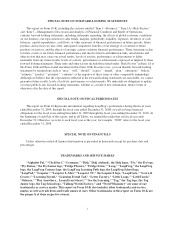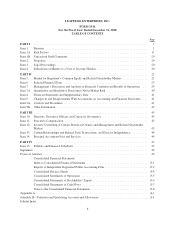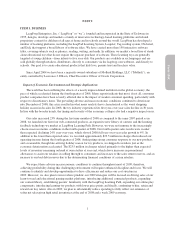LeapFrog 2008 Annual Report Download - page 18
Download and view the complete annual report
Please find page 18 of the 2008 LeapFrog annual report below. You can navigate through the pages in the report by either clicking on the pages listed below, or by using the keyword search tool below to find specific information within the annual report.
Intellectual Property and Licenses
We rely on a combination of patent, trademark, copyright and trade secret laws in the United States and
other jurisdictions as well as confidentiality procedures and contractual provisions to protect our brand and our
proprietary technology and information.
We maintain an active program to protect our investment in technology and brands by attempting to secure
patent rights, trademark registrations and other intellectual property registrations. We have filed and obtained a
number of patents in the United States and abroad. We believe that the duration of the applicable patents we are
granted is adequate relative to the expected lives of our products. While our patents are an important element of
the protection of our intellectual property, our business as a whole is not materially dependent on any one patent.
For a discussion of how our intellectual property rights may not prevent our competitors from using similar
or identical technology, Part I, Item 1A.—Risk Factors—“Our intellectual property rights may not prevent our
competitors from using our technologies or similar technologies to develop competing products, which could
weaken our competitive position and harm our operating results .” For a discussion of how our intellectual
property rights may not insulate us from claims of infringement by third parties, see Part I, Item 1A.—Risk
Factors—“Third parties have claimed, and may claim in the future, that we are infringing their intellectual
property rights, which may cause us to incur significant litigation or licensing expenses or to stop selling some of
our products or using some of our trademarks.”
In addition to proprietary materials we have developed, we license content from third parties under
exclusive and nonexclusive agreements, which allow us to use third-party characters, stories, illustrations and
trade names in specified geographic territories. These inbound licenses are typically limited to use of the licensed
content in specific products for specific time periods. Significant portions of the software content for our
platforms contain content that is licensed from third parties. Our continued use of these rights is dependent on
our ability to continue to obtain license rights at reasonable rates.
We also license our trademarks or service marks to third parties for manufacturing, marketing, distribution
and sale of various products. Our licensing strategy concentrates on extending our current brand through third-
party products that are consistent with our core commitment to the design and development of educational
products that make learning fun and engaging.
Seasonality
Our business is highly seasonal in both of our segments, with our retail customers making a large percentage
of all purchases in preparation for the traditional holiday season. Our business, being subject to these significant
seasonal fluctuations, generally earns the majority of our net sales and all of our net income, if any, during the
third and fourth calendar quarters. Our seasonal sales patterns for the years ended December 31, 2008, 2007 and
2006 are shown in the table below.
Years Ending December 31,
2008 2007 2006
Percent of total net sales:
1st quarter ................................................ 13% 14% 13%
2nd quarter ............................................... 15% 13% 13%
3rd quarter ................................................ 43% 32% 37%
4th quarter ................................................ 29% 41% 37%
Total ................................................ 100% 100% 100%
These seasonal purchasing patterns and their related production lead times create risk in our business due to
possible under-production of popular items and over-production of items that do not match consumer demand. In
addition, as recession has progressed, we have seen our customers start to manage their inventories more
8
























